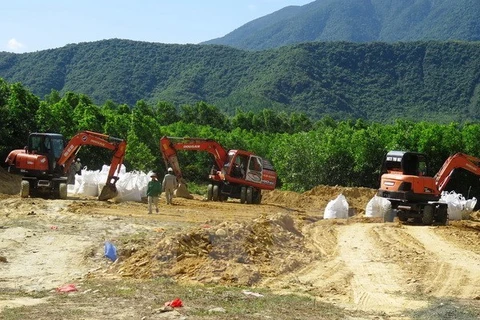Hanoi (VNA) - Vo Tuan Nhan, Deputy Minister of Natural Resources and Environment, speaks to Infonet.vn on the role of local authorities in projects licensed by the central Government.
Q: How do we maintain Government’s pledge not to exchange the environment for development?
A: In Instruction No.25 on urgent tasks and measures to protect the environment, the Government reiterated Vietnam’s point of view that it will not accept any investment project that will seriously affect the environment.
The document says that the process of environmental impact assessment (EIA) will be conducted carefully and thoroughly on projects which may cause negative impacts on the environment like forest destruction or encroaching upon biology conservation zones; or projects that will discharge a great volume of waste water from sensitive industries like steel production, paper pulp or textile dyes and pigments.
During the project approval process, we will say no to any project that uses outdated technology. What we want to do is not to turn our country into the world’s industrial dumping site.
There is an argument saying that our current environmental norms and criteria are out of date and it is time for the country to update them to be on par internationally. What do you think?
In the initial period of industrialisation and modernisation, we were a bit hasty in our development. This is normal in almost all countries. We can’t shift the blame to our poor management capacity. However, I have to admit that we have not paid due attention to the work of environmental protection, particularly the selection of proper technology, industry or investment fields.
Last but not least, during the process of project approval, authorities in some localities have not paid due attention to environmental protection procedures but to economic development and income generation. As time goes by the problem has grown. We now have to pay a high price for some of our negligence.
Q: How should we define the responsibility of local or central authorities when an environmental incident occurs?
A: The Law on Environmental Protection spells out clearly the tasks and responsibilities of local and central governments. We live in a society ruled by law.
Under the law, the central government will only grant licences to big projects. However, that doesn’t mean that if the government granted the licencce, it has to manage the project. The local government has to do the day to day management.
For example, if the project is located in a commune, it’s the commune’s task to handle any mishap which may arise during the project’s life cycle, including a natural calamity or an environmental accident. Of course, in a serious case, communal authorities have to report the incident to the district people’s committee and the district committee has to report to the provincial people’s committee.
If the project is located between the two districts or more, provincial authorities will have responsibility. If it is related to two provinces or more, the central government will have to intervene.
In short, immediate government where the project is located will be the project’s first line management unit, not the central government. We have to follow the management flow as I have explained above.
Q: Why have coastal areas recently become popular among steel mill investors?
A: As we all know iron and steel products are very heavy and sea transportation is the cheapest way to move these products. That’s why many investors build steel mills in coastal areas.
So, it is not wrong to grant investment licences to them in coastal areas. This is one way to help the enterprises do their business. But the question is how to control their waste treatment.
However, we can’t afford to grant permits to any steel mills in tourist sites along coastal areas or in aqua-culture areas either.
On the other hand, we have to do the zoning carefully for steel mills to operate so that we can monitor the solid waste treatment, air emission and waste water discharge to ensure they meet our standards.
Q: What lessons have we learned from the Formosa incident?
A: The Ministry of Natural Resources and Environment (MONRE) has paid special attention to “sensitive” projects like steel mills, textile dyes and pigments, pulp plants, fertiliser plants and others. These projects have potential to cause pollution so we must impose stricter controls on them, but on the other hand we will create conditions for them to develop.
In 2017, the MONRE will do national environment planning and of course, the planning work for these “sensitive” projects will be an important component.
For the time being, the strategic environmental assessment report must raise red alarms for potential risks for each locality so that local authorities think twice before approving projects.-VNA
























